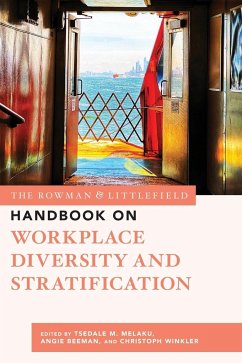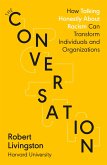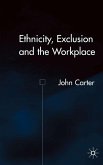The Rowman & Littlefield Handbook on Workplace Diversity and Stratification
Herausgeber: Melaku, Tsedale M.; Winkler, Christoph; Beeman, Angie
The Rowman & Littlefield Handbook on Workplace Diversity and Stratification
Herausgeber: Melaku, Tsedale M.; Winkler, Christoph; Beeman, Angie
- Gebundenes Buch
- Merkliste
- Auf die Merkliste
- Bewerten Bewerten
- Teilen
- Produkt teilen
- Produkterinnerung
- Produkterinnerung
A comprehensive and authoritative exploration of diversity and stratification in the workplace by leading scholars in the field.
Andere Kunden interessierten sich auch für
![The Rowman & Littlefield Handbook of Policing, Communication, and Society The Rowman & Littlefield Handbook of Policing, Communication, and Society]() The Rowman & Littlefield Handbook of Policing, Communication, and Society58,99 €
The Rowman & Littlefield Handbook of Policing, Communication, and Society58,99 €![The Rowman & Littlefield Handbook of Policing, Communication, and Society The Rowman & Littlefield Handbook of Policing, Communication, and Society]() The Rowman & Littlefield Handbook of Policing, Communication, and Society177,99 €
The Rowman & Littlefield Handbook of Policing, Communication, and Society177,99 €![The Conversation The Conversation]() Robert LivingstonThe Conversation12,99 €
Robert LivingstonThe Conversation12,99 €![Diversity and Inclusion in the Global Workplace Diversity and Inclusion in the Global Workplace]() Diversity and Inclusion in the Global Workplace121,99 €
Diversity and Inclusion in the Global Workplace121,99 €![The Workplace Violence Prevention Handbook The Workplace Violence Prevention Handbook]() Don PhilpottThe Workplace Violence Prevention Handbook82,99 €
Don PhilpottThe Workplace Violence Prevention Handbook82,99 €![Sway Sway]() Pragya AgarwalSway10,99 €
Pragya AgarwalSway10,99 €![Ethnicity, Exclusion and the Workplace Ethnicity, Exclusion and the Workplace]() J. CarterEthnicity, Exclusion and the Workplace81,99 €
J. CarterEthnicity, Exclusion and the Workplace81,99 €-
-
-
A comprehensive and authoritative exploration of diversity and stratification in the workplace by leading scholars in the field.
Hinweis: Dieser Artikel kann nur an eine deutsche Lieferadresse ausgeliefert werden.
Hinweis: Dieser Artikel kann nur an eine deutsche Lieferadresse ausgeliefert werden.
Produktdetails
- Produktdetails
- Verlag: Rowman & Littlefield Publishers
- Seitenzahl: 500
- Erscheinungstermin: 28. September 2023
- Englisch
- Abmessung: 260mm x 183mm x 31mm
- Gewicht: 1126g
- ISBN-13: 9781538144374
- ISBN-10: 1538144379
- Artikelnr.: 68175081
- Herstellerkennzeichnung
- Libri GmbH
- Europaallee 1
- 36244 Bad Hersfeld
- gpsr@libri.de
- Verlag: Rowman & Littlefield Publishers
- Seitenzahl: 500
- Erscheinungstermin: 28. September 2023
- Englisch
- Abmessung: 260mm x 183mm x 31mm
- Gewicht: 1126g
- ISBN-13: 9781538144374
- ISBN-10: 1538144379
- Artikelnr.: 68175081
- Herstellerkennzeichnung
- Libri GmbH
- Europaallee 1
- 36244 Bad Hersfeld
- gpsr@libri.de
Edited by Tsedale M. Melaku; Angie Beeman and Christoph Winkler
Outline/Table of Contents
Foreword
1. Introduction: The introduction will lay out the goals of the handbook;
situate the context of workplace diversity and stratification in the United
States; and provide a broad overview of the contents of the handbook
Theoretical Foundations of Diversity and Stratification
The following chapters specifically engage theories derived from various
discipline research on diversity and stratification, including
race/gender/class/ and how varying identities that intersect create
disadvantage or advantage to particular groups.
2. Critical Diversity Perspective: this perspective examines all forms of
social inequality, oppression, and stratification that revolve around
issues of differences
3. Race, Gender & Authority in the Workplace: sociological approaches to job
authority in determining social inequality in the workplace
4. A Psychological Perspective: conceptualizing workplace diversity through
stigma theory and research in order to social value and attributes which
become consequential to both individuals and organizations
5. A Business Management Perspective: social capital and social network
theories in examining diversity and productivity in business management
Key Sites of Contention
The following chapters will tackle specific issues in diversity research,
from debates on inclusion, quotas, race/ethnicity, gender, age, ability,
language/culture, and sexual identity.
6. Diversity: A Culture of Inclusion?: understanding what diversity research
actually is and how inclusion becomes the central focus in promoting
integrated practices within organizations; defining diversity and inclusion
as more than a buzzword
7. The Problem with Quotas: Doing the Bare Minimum to Achieve Diversity:
efficacy of best practices or policies (i.e. affirmative action) to promote
diversity in workplaces
8. Managing workplace Diversity: The Role of Race in America: social policies
designed to increase equality of opportunity in the workplace; managerial
responses to diversity, ethnoracial and gender stratification at work, the
determinants of and rewards for job authority, effects of diversity on work
outcomes
9. Gender Parity in the Boardroom: examination of how gender diversity on
corporate boards influence corporate governance outcomes that subsequently
impact performance
10. Bridging the Gap Between Generations: Value in Difference: examining the
multiplicative effects of workplace discrimination and health on life
satisfaction
11. Equitable Accommodations: Challenges Employees with Physical and Mental
Disabilities Face: exploration of the ways in which employees with physical
and or mental disabilities face continued challenges navigating space and
access within organizations
12. LGBTQ+ Diversity: Language and Communication: this chapter will explore the
usage of language to communicate difference in gender and sexuality within
professional organizations, including challenges LGBTQ+ members face
attempting to bring their whole selves to work; and combating unconscious
bias
Empirical Diversity/Stratification Studies
The following chapters will engage various studies that examine diversity
in specific professional settings, including education, medicine, law,
corporations, religious institutions, entrepreneurship, and human resources
research
13. Faculty of Color in Higher Education: examining the challenges faculty of
color in higher educational institutions, including hiring, review
processes and tenure and promotion
14. Black Medical Professionals: intersection of race, gender, work, and
inequality in the medical field
15. Diversity in Law Firms: influence of race and gender on advancement
prospects of lawyers in elite firms
16. Corporations: Gender Equity and Mentorship: obstacles women face in
corporations securing mentors and sponsors in the workplace
17. Black Women in the Church: this chapter will discuss how Black women today
navigate the male-dominated space of professional ministry
18. Entrepreneurship and Diversity: this chapter examines issues, challenges
and opportunities related to diversity within entrepreneurship ecosystems
19. Human Resources and the Impact of Diversity: exploring the impacts felt by
organizations that understand the importance of not just espousing the
notion of diversity but enacting the principles; how organizations will
respond to the satisfaction of their market that has become increasingly
stratified; and are the choices of diversity and stratification mutually
exclusive for those focused on viability as long-term concern
Diversity in the Larger Context
The following chapters will discuss diversity and inclusion in the broader
context of organizational practices, effectiveness of policies and
programs, implications for workplace changes and value derived
20. Mitigating Bias in the Workplace: this chapter will focus on reducing
discrimination in the workplace
21. Organizational Effectiveness: developing organizational capability and
enhancing effectiveness through the strategic management of people,
particularly diverse work teams
22. Implications of Diversity and Inclusion in the Workplace: this chapter will
explore exactly what the benefits and drawbacks of having diversity and
inclusion initiatives in organizations, exploring the effectiveness of
programs
23. The Meaning of Diversity in the Workplace: the value of diversity, how this
affects the organization as a whole, who/how do organizations benefit from
diversity; expectations of the organization (Does Diversity Pay?)
Foreword
1. Introduction: The introduction will lay out the goals of the handbook;
situate the context of workplace diversity and stratification in the United
States; and provide a broad overview of the contents of the handbook
Theoretical Foundations of Diversity and Stratification
The following chapters specifically engage theories derived from various
discipline research on diversity and stratification, including
race/gender/class/ and how varying identities that intersect create
disadvantage or advantage to particular groups.
2. Critical Diversity Perspective: this perspective examines all forms of
social inequality, oppression, and stratification that revolve around
issues of differences
3. Race, Gender & Authority in the Workplace: sociological approaches to job
authority in determining social inequality in the workplace
4. A Psychological Perspective: conceptualizing workplace diversity through
stigma theory and research in order to social value and attributes which
become consequential to both individuals and organizations
5. A Business Management Perspective: social capital and social network
theories in examining diversity and productivity in business management
Key Sites of Contention
The following chapters will tackle specific issues in diversity research,
from debates on inclusion, quotas, race/ethnicity, gender, age, ability,
language/culture, and sexual identity.
6. Diversity: A Culture of Inclusion?: understanding what diversity research
actually is and how inclusion becomes the central focus in promoting
integrated practices within organizations; defining diversity and inclusion
as more than a buzzword
7. The Problem with Quotas: Doing the Bare Minimum to Achieve Diversity:
efficacy of best practices or policies (i.e. affirmative action) to promote
diversity in workplaces
8. Managing workplace Diversity: The Role of Race in America: social policies
designed to increase equality of opportunity in the workplace; managerial
responses to diversity, ethnoracial and gender stratification at work, the
determinants of and rewards for job authority, effects of diversity on work
outcomes
9. Gender Parity in the Boardroom: examination of how gender diversity on
corporate boards influence corporate governance outcomes that subsequently
impact performance
10. Bridging the Gap Between Generations: Value in Difference: examining the
multiplicative effects of workplace discrimination and health on life
satisfaction
11. Equitable Accommodations: Challenges Employees with Physical and Mental
Disabilities Face: exploration of the ways in which employees with physical
and or mental disabilities face continued challenges navigating space and
access within organizations
12. LGBTQ+ Diversity: Language and Communication: this chapter will explore the
usage of language to communicate difference in gender and sexuality within
professional organizations, including challenges LGBTQ+ members face
attempting to bring their whole selves to work; and combating unconscious
bias
Empirical Diversity/Stratification Studies
The following chapters will engage various studies that examine diversity
in specific professional settings, including education, medicine, law,
corporations, religious institutions, entrepreneurship, and human resources
research
13. Faculty of Color in Higher Education: examining the challenges faculty of
color in higher educational institutions, including hiring, review
processes and tenure and promotion
14. Black Medical Professionals: intersection of race, gender, work, and
inequality in the medical field
15. Diversity in Law Firms: influence of race and gender on advancement
prospects of lawyers in elite firms
16. Corporations: Gender Equity and Mentorship: obstacles women face in
corporations securing mentors and sponsors in the workplace
17. Black Women in the Church: this chapter will discuss how Black women today
navigate the male-dominated space of professional ministry
18. Entrepreneurship and Diversity: this chapter examines issues, challenges
and opportunities related to diversity within entrepreneurship ecosystems
19. Human Resources and the Impact of Diversity: exploring the impacts felt by
organizations that understand the importance of not just espousing the
notion of diversity but enacting the principles; how organizations will
respond to the satisfaction of their market that has become increasingly
stratified; and are the choices of diversity and stratification mutually
exclusive for those focused on viability as long-term concern
Diversity in the Larger Context
The following chapters will discuss diversity and inclusion in the broader
context of organizational practices, effectiveness of policies and
programs, implications for workplace changes and value derived
20. Mitigating Bias in the Workplace: this chapter will focus on reducing
discrimination in the workplace
21. Organizational Effectiveness: developing organizational capability and
enhancing effectiveness through the strategic management of people,
particularly diverse work teams
22. Implications of Diversity and Inclusion in the Workplace: this chapter will
explore exactly what the benefits and drawbacks of having diversity and
inclusion initiatives in organizations, exploring the effectiveness of
programs
23. The Meaning of Diversity in the Workplace: the value of diversity, how this
affects the organization as a whole, who/how do organizations benefit from
diversity; expectations of the organization (Does Diversity Pay?)
Outline/Table of Contents
Foreword
1. Introduction: The introduction will lay out the goals of the handbook;
situate the context of workplace diversity and stratification in the United
States; and provide a broad overview of the contents of the handbook
Theoretical Foundations of Diversity and Stratification
The following chapters specifically engage theories derived from various
discipline research on diversity and stratification, including
race/gender/class/ and how varying identities that intersect create
disadvantage or advantage to particular groups.
2. Critical Diversity Perspective: this perspective examines all forms of
social inequality, oppression, and stratification that revolve around
issues of differences
3. Race, Gender & Authority in the Workplace: sociological approaches to job
authority in determining social inequality in the workplace
4. A Psychological Perspective: conceptualizing workplace diversity through
stigma theory and research in order to social value and attributes which
become consequential to both individuals and organizations
5. A Business Management Perspective: social capital and social network
theories in examining diversity and productivity in business management
Key Sites of Contention
The following chapters will tackle specific issues in diversity research,
from debates on inclusion, quotas, race/ethnicity, gender, age, ability,
language/culture, and sexual identity.
6. Diversity: A Culture of Inclusion?: understanding what diversity research
actually is and how inclusion becomes the central focus in promoting
integrated practices within organizations; defining diversity and inclusion
as more than a buzzword
7. The Problem with Quotas: Doing the Bare Minimum to Achieve Diversity:
efficacy of best practices or policies (i.e. affirmative action) to promote
diversity in workplaces
8. Managing workplace Diversity: The Role of Race in America: social policies
designed to increase equality of opportunity in the workplace; managerial
responses to diversity, ethnoracial and gender stratification at work, the
determinants of and rewards for job authority, effects of diversity on work
outcomes
9. Gender Parity in the Boardroom: examination of how gender diversity on
corporate boards influence corporate governance outcomes that subsequently
impact performance
10. Bridging the Gap Between Generations: Value in Difference: examining the
multiplicative effects of workplace discrimination and health on life
satisfaction
11. Equitable Accommodations: Challenges Employees with Physical and Mental
Disabilities Face: exploration of the ways in which employees with physical
and or mental disabilities face continued challenges navigating space and
access within organizations
12. LGBTQ+ Diversity: Language and Communication: this chapter will explore the
usage of language to communicate difference in gender and sexuality within
professional organizations, including challenges LGBTQ+ members face
attempting to bring their whole selves to work; and combating unconscious
bias
Empirical Diversity/Stratification Studies
The following chapters will engage various studies that examine diversity
in specific professional settings, including education, medicine, law,
corporations, religious institutions, entrepreneurship, and human resources
research
13. Faculty of Color in Higher Education: examining the challenges faculty of
color in higher educational institutions, including hiring, review
processes and tenure and promotion
14. Black Medical Professionals: intersection of race, gender, work, and
inequality in the medical field
15. Diversity in Law Firms: influence of race and gender on advancement
prospects of lawyers in elite firms
16. Corporations: Gender Equity and Mentorship: obstacles women face in
corporations securing mentors and sponsors in the workplace
17. Black Women in the Church: this chapter will discuss how Black women today
navigate the male-dominated space of professional ministry
18. Entrepreneurship and Diversity: this chapter examines issues, challenges
and opportunities related to diversity within entrepreneurship ecosystems
19. Human Resources and the Impact of Diversity: exploring the impacts felt by
organizations that understand the importance of not just espousing the
notion of diversity but enacting the principles; how organizations will
respond to the satisfaction of their market that has become increasingly
stratified; and are the choices of diversity and stratification mutually
exclusive for those focused on viability as long-term concern
Diversity in the Larger Context
The following chapters will discuss diversity and inclusion in the broader
context of organizational practices, effectiveness of policies and
programs, implications for workplace changes and value derived
20. Mitigating Bias in the Workplace: this chapter will focus on reducing
discrimination in the workplace
21. Organizational Effectiveness: developing organizational capability and
enhancing effectiveness through the strategic management of people,
particularly diverse work teams
22. Implications of Diversity and Inclusion in the Workplace: this chapter will
explore exactly what the benefits and drawbacks of having diversity and
inclusion initiatives in organizations, exploring the effectiveness of
programs
23. The Meaning of Diversity in the Workplace: the value of diversity, how this
affects the organization as a whole, who/how do organizations benefit from
diversity; expectations of the organization (Does Diversity Pay?)
Foreword
1. Introduction: The introduction will lay out the goals of the handbook;
situate the context of workplace diversity and stratification in the United
States; and provide a broad overview of the contents of the handbook
Theoretical Foundations of Diversity and Stratification
The following chapters specifically engage theories derived from various
discipline research on diversity and stratification, including
race/gender/class/ and how varying identities that intersect create
disadvantage or advantage to particular groups.
2. Critical Diversity Perspective: this perspective examines all forms of
social inequality, oppression, and stratification that revolve around
issues of differences
3. Race, Gender & Authority in the Workplace: sociological approaches to job
authority in determining social inequality in the workplace
4. A Psychological Perspective: conceptualizing workplace diversity through
stigma theory and research in order to social value and attributes which
become consequential to both individuals and organizations
5. A Business Management Perspective: social capital and social network
theories in examining diversity and productivity in business management
Key Sites of Contention
The following chapters will tackle specific issues in diversity research,
from debates on inclusion, quotas, race/ethnicity, gender, age, ability,
language/culture, and sexual identity.
6. Diversity: A Culture of Inclusion?: understanding what diversity research
actually is and how inclusion becomes the central focus in promoting
integrated practices within organizations; defining diversity and inclusion
as more than a buzzword
7. The Problem with Quotas: Doing the Bare Minimum to Achieve Diversity:
efficacy of best practices or policies (i.e. affirmative action) to promote
diversity in workplaces
8. Managing workplace Diversity: The Role of Race in America: social policies
designed to increase equality of opportunity in the workplace; managerial
responses to diversity, ethnoracial and gender stratification at work, the
determinants of and rewards for job authority, effects of diversity on work
outcomes
9. Gender Parity in the Boardroom: examination of how gender diversity on
corporate boards influence corporate governance outcomes that subsequently
impact performance
10. Bridging the Gap Between Generations: Value in Difference: examining the
multiplicative effects of workplace discrimination and health on life
satisfaction
11. Equitable Accommodations: Challenges Employees with Physical and Mental
Disabilities Face: exploration of the ways in which employees with physical
and or mental disabilities face continued challenges navigating space and
access within organizations
12. LGBTQ+ Diversity: Language and Communication: this chapter will explore the
usage of language to communicate difference in gender and sexuality within
professional organizations, including challenges LGBTQ+ members face
attempting to bring their whole selves to work; and combating unconscious
bias
Empirical Diversity/Stratification Studies
The following chapters will engage various studies that examine diversity
in specific professional settings, including education, medicine, law,
corporations, religious institutions, entrepreneurship, and human resources
research
13. Faculty of Color in Higher Education: examining the challenges faculty of
color in higher educational institutions, including hiring, review
processes and tenure and promotion
14. Black Medical Professionals: intersection of race, gender, work, and
inequality in the medical field
15. Diversity in Law Firms: influence of race and gender on advancement
prospects of lawyers in elite firms
16. Corporations: Gender Equity and Mentorship: obstacles women face in
corporations securing mentors and sponsors in the workplace
17. Black Women in the Church: this chapter will discuss how Black women today
navigate the male-dominated space of professional ministry
18. Entrepreneurship and Diversity: this chapter examines issues, challenges
and opportunities related to diversity within entrepreneurship ecosystems
19. Human Resources and the Impact of Diversity: exploring the impacts felt by
organizations that understand the importance of not just espousing the
notion of diversity but enacting the principles; how organizations will
respond to the satisfaction of their market that has become increasingly
stratified; and are the choices of diversity and stratification mutually
exclusive for those focused on viability as long-term concern
Diversity in the Larger Context
The following chapters will discuss diversity and inclusion in the broader
context of organizational practices, effectiveness of policies and
programs, implications for workplace changes and value derived
20. Mitigating Bias in the Workplace: this chapter will focus on reducing
discrimination in the workplace
21. Organizational Effectiveness: developing organizational capability and
enhancing effectiveness through the strategic management of people,
particularly diverse work teams
22. Implications of Diversity and Inclusion in the Workplace: this chapter will
explore exactly what the benefits and drawbacks of having diversity and
inclusion initiatives in organizations, exploring the effectiveness of
programs
23. The Meaning of Diversity in the Workplace: the value of diversity, how this
affects the organization as a whole, who/how do organizations benefit from
diversity; expectations of the organization (Does Diversity Pay?)








